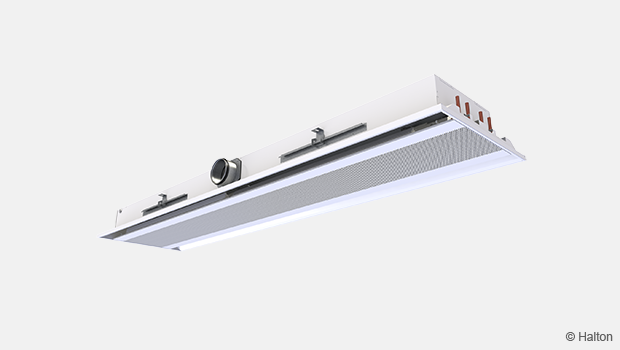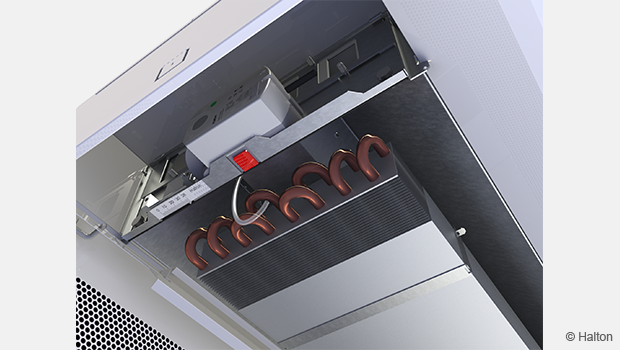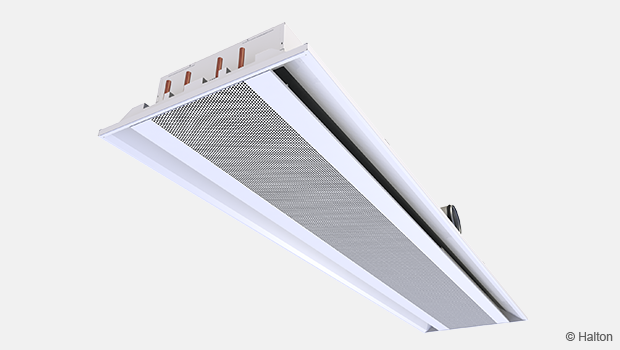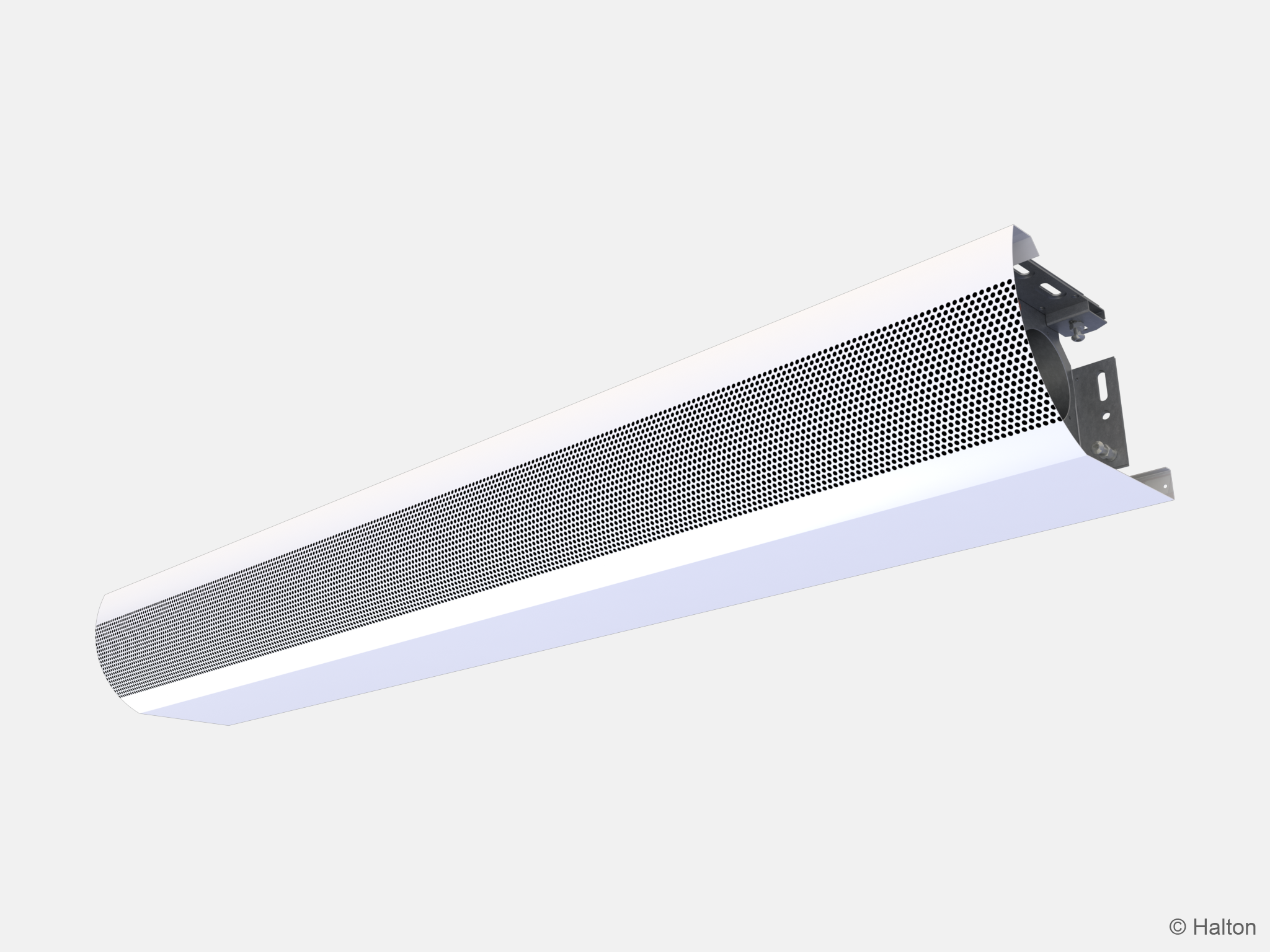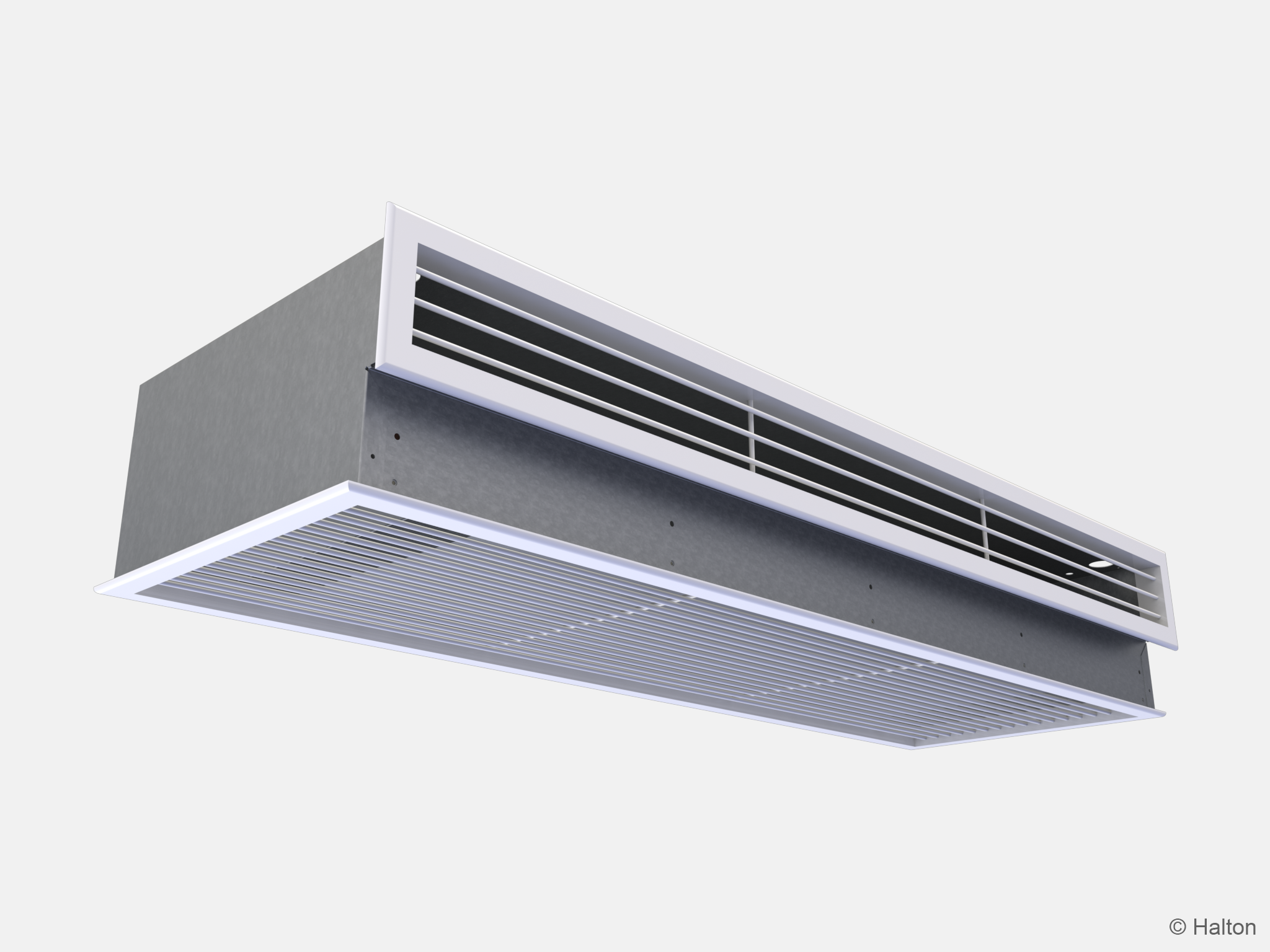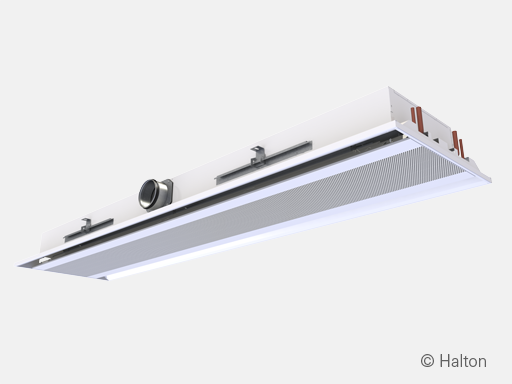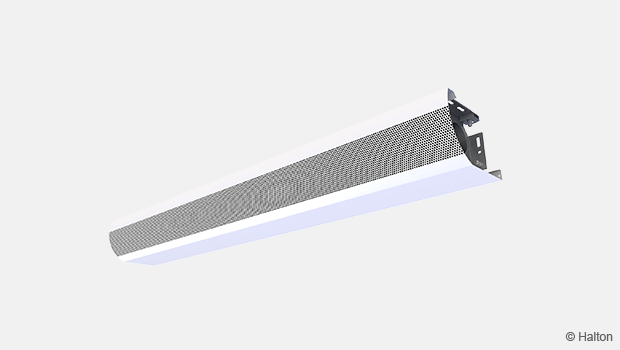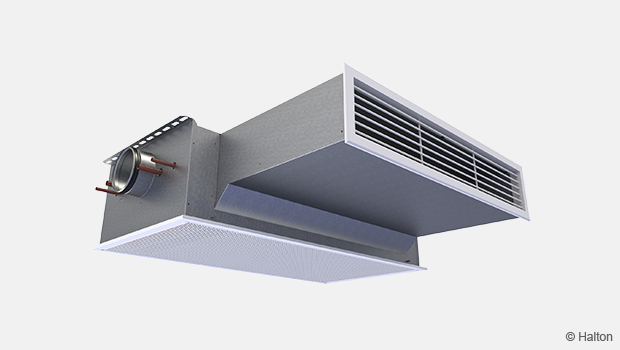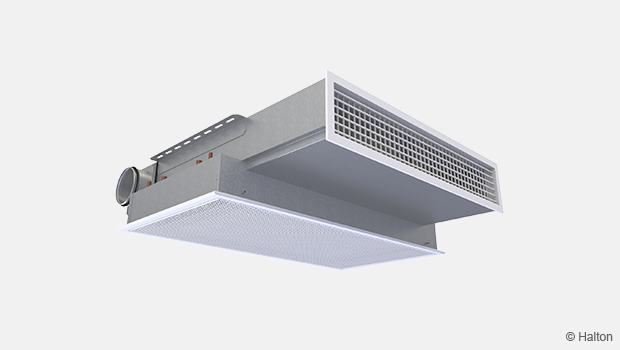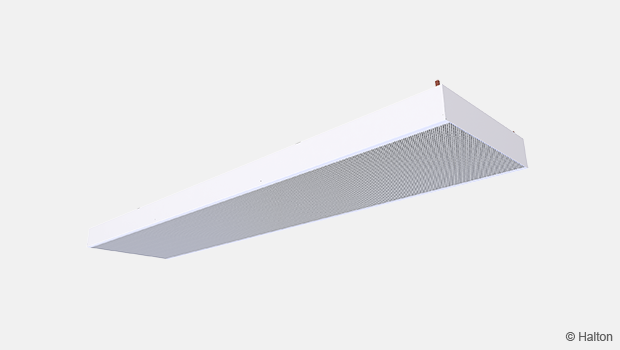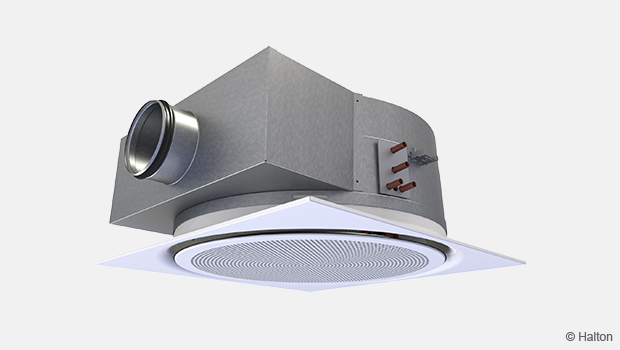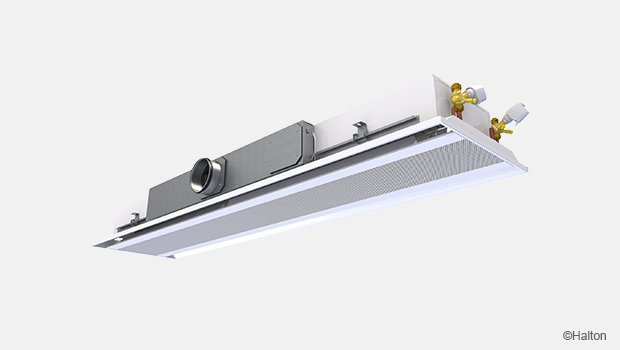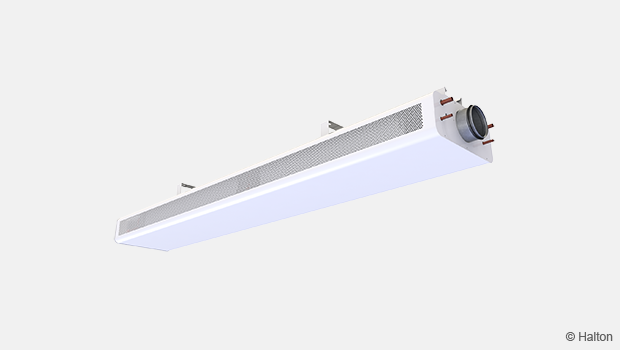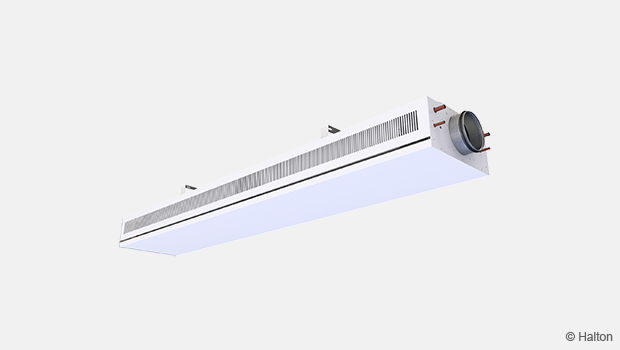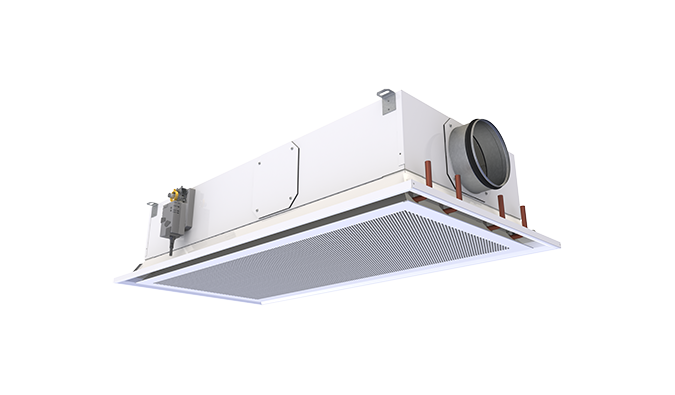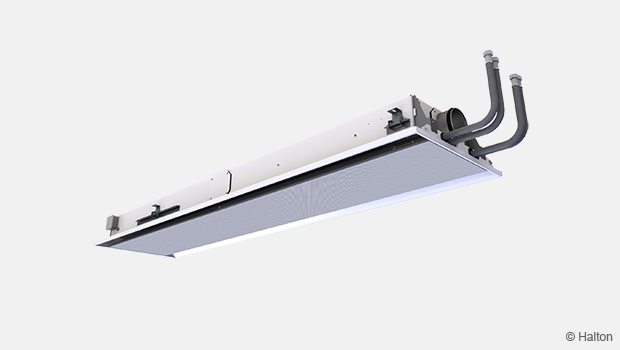Product / RE6
Halton Rex RE6 – Chilled beam
Adaptable active chilled beam for integrated installation
- Flexible, ceiling-integrated chilled beam unit for applications where high-quality comfort conditions, demand-based ventilation, and individual room control are needed.
Overview
Halton Rex 600 chilled beam is:
- Combined cooling, heating, and supply air unit for flush installation within a suspended ceiling.
- Well suited for spaces with high cooling loads, low humidity load, and variable ventilation requirements.
- Ideal solution for applications where high-quality environmental conditions, demand-based ventilation, and individual room control are appreciated.
Typical applications: office rooms, landscape offices and meeting rooms.
The Halton Rex 600 chilled beam is designed for typical office space ventilation requirements with high flexibility of the airflow adjustability. The Halton Rex 600 operation can be easily adapted to changed operation conditions and requirements from the design to the end of the building life cycle.
- Easy and fast selection with Halton eHIT design tool
- Individually adjustable velocity conditions with Halton Velocity Control (HVC)
- In-built flexibility of operation for partition wall relocations with Halton Velocity Control
- Individually adjustable supply air flow rate for changes in space layout using Halton Air Quality (HAQ) control
- Demand based control of supply air flow rate for efficient use of energy in constant-pressure ductwork zone applications; when the air flow rate changes have no effect on the coil cooling/heating capacities of the chilled beam.
- Effective site logistics
- Enhanced life cycle performance with optimised low air and water flow rates
Product models
- Model with combined cooling and heating exchanger
- Model with manual or motorised Halton Air Quality (HAQ)
- Model with integrated exhaust valve
- Model with high efficiency coil
- Model with Halton Workplace WRA room automation system package
Halton chilled beams are certified by Eurovent Certita.

Dimensions and weight
Main dimensions
Total length 1200 – 2400 mm
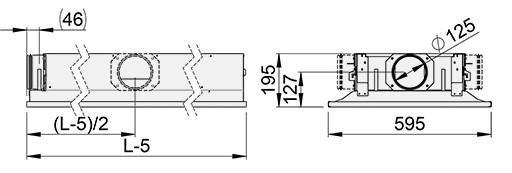
Total length 2500 – 3600 mm
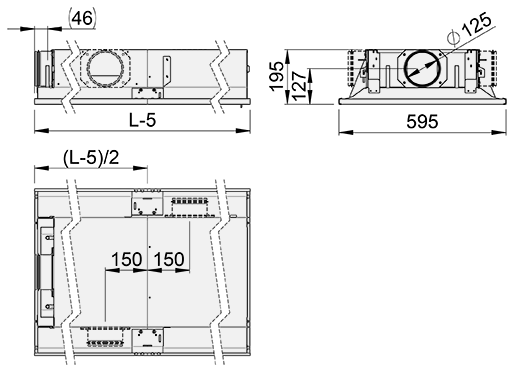
Note: For lower models (min.145 mm), please contact sales.
| Coil length | 900, +100, …, 3300 |
| L-5 | 1195, +100, …, 3595 (+1715) |
| Weight (kg/m) | 14 |
Coil pipe dimensions
Normal efficiency (CE=N)
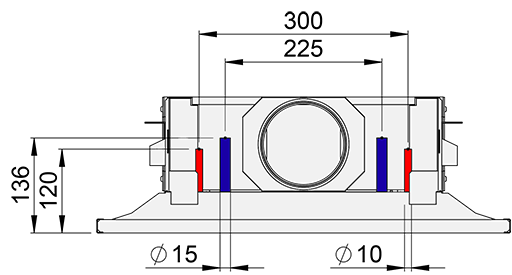
High efficiency coil, single loop (CE=H1)
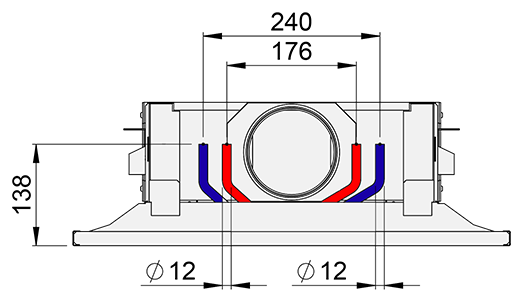
High efficiency coil, twin loop (CE=H2)
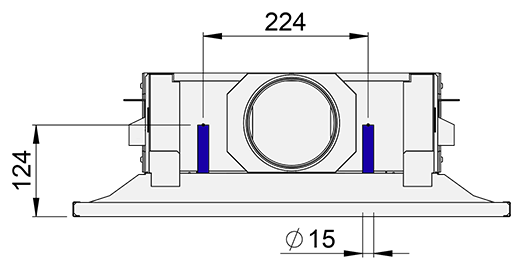
Standard, cooling (CE=S)
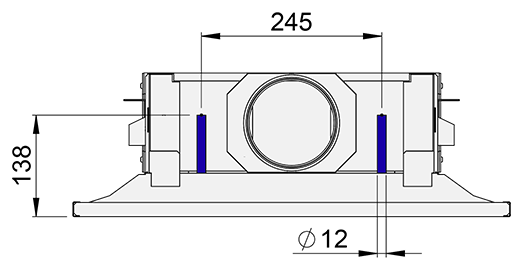
Standard, cooling, low pressure drop (CE=SL)
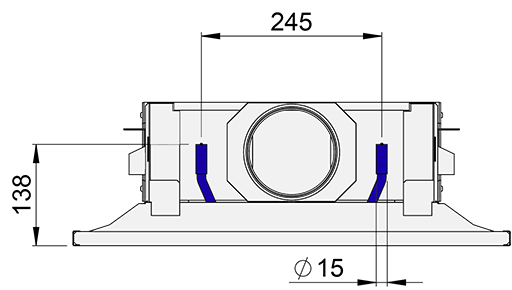
Standard, cooling and heating (CE=SH)
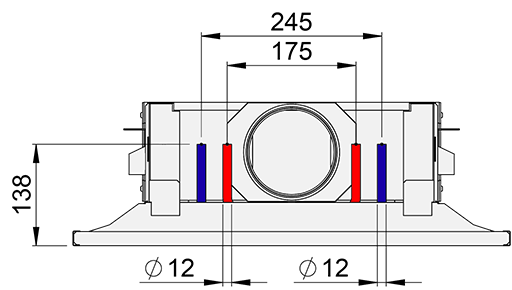
Model with integrated exhaust (EX=A)
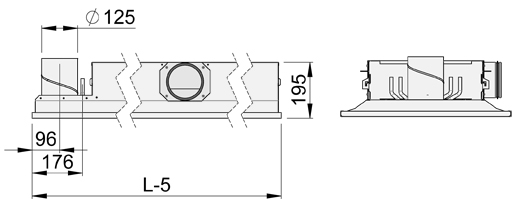
Integration with suspended ceiling
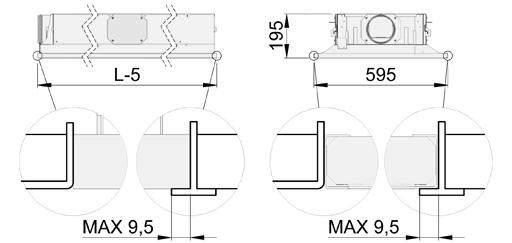
Material
| Part | Material | Finishing | Note |
| Front panel | Pre-painted galvanise steel |
Polyester-painted, white (RAL 9003 or RAL 9010, 20% gloss) |
Special colours available Polyester-epoxy-painted |
| Side plates | Pre-painted galvanised steel |
Polyester-painted, white (RAL 9003 or RAL 9010, 20% gloss) |
Special colours available Polyester-epoxy-painted |
| End plates | Galvanised steel | Polyester-epoxy-painted, white (RAL 9003 or RAL 9010, 20% gloss) |
Special colours available |
| Supply air plenum |
Galvanised steel | – | – |
| Brackets | Galvanised steel | – | – |
| Coil pipes | Copper | – | – |
| Coil fins | Aluminium | – | – |
| Exhaust valve | Galvanised steel | Polyester-epoxy-painted, white (RAL 9003 / 30% gloss) |
See Halton URH valve 125 mm |
Cooling/heating water pipe connections are Cu15/Cu12/Cu10 with wall thickness of 0.9-1.0 mm fulfilling European Standard EN 1057:1996.
The maximum chilled/hot water circuit operating pressure is 1.0 MPa. The supply air duct connection is 125 mm.
Accessories
| Accessory/option | Code | Description | Note |
| Combinedcooling and heating coil |
TC=H | Coil with hot water circulation |
Cooling/heating copper water pipe connections are Ø 15/10 or 12 mm (see section Dimensions) |
| Halton Air Quality control (HAQ damper) |
AQ=MA | Manual operation | – |
| AQ=MO | Motorised operation. Power supply: 24 VAC. Control signal: 0 … 10 VDC. |
– | |
| AQ=RE | Retrofit | – | |
| Integrated exhaust valve |
EX=A | Integrated exhaust valve located in the front end of the chilled beam |
Effective coil length L – 500 mm |
| Adapters for Clip-In ceiling installation (Dampa) |
IO=DC | Installation within Clip-In ceiling |
Available as tailored solution |
Effective coil length
| Accessory option | Code | Effective coil length |
| Without HAQ | AQ=NA | L – 200 mm |
| With HAQ | AQ=MA, MO, RE | L – 300 mm |
| With URH | EX=A | L – 500 mm |
Exhaust valve integration
The Halton Rex 600 chilled beam can be equipped with an integrated exhaust valve, providing air supply and exhaust in the same unit. The integrated exhaust valve decreases the effective length to total length 500 mm (L – 500 mm) (for standard chilled beam L-300).
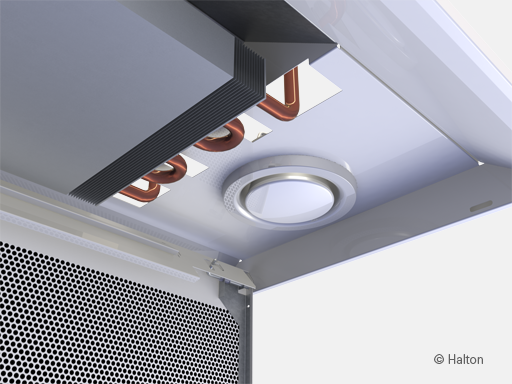
Function
The Halton Rex 600 chilled beam is designed to be installed flush with a suspended ceiling.
The primary supply air enters the plenum of the active chilled beam. From there it is diffused into the room through nozzles and the diffuser of the HAQ- control. Supply slots located at the bottom of the beam.
The supply air nozzle jets efficiently induce ambient room air. The induced air flows through the heat exchanger, where it is either cooled or heated.
The supply air jet is directed horizontally along the ceiling surface.
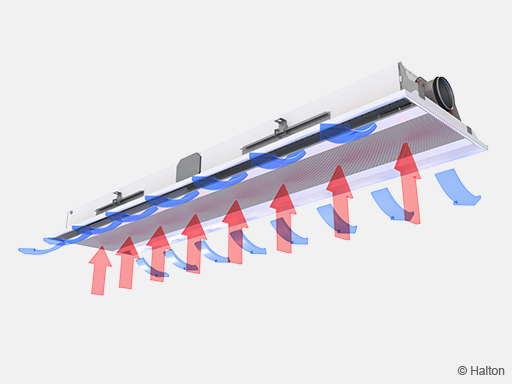
Velocity control in the occupied zone
Halton Velocity Control (HVC) is used for adjusting room air velocity conditions either when room layout is changed (e.g., in cases where the partition wall is located near the chilled beam) or when local, individual velocity conditions need to be altered. HVC adjustment has an impact on the induced room air flow through the heat exchanger, and therefore it either increases or decreases both the velocities in the occupied zone and the cooling/heating capacity of the chilled beam.

Pos.1 = Throttle position Pos.2 = Normal position Pos.3 = Boost position
The HVC damper is divided into sections (Pos.1-3) to enable the adjustment of conditions in different parts of the occupied zone.
It is recommended to design the chilled beam in the normal position in order to allow both throttle and boost functions during the building s life cycle.
Airflow rate control
The supply air flow of the chilled beam nozzle jets are dependent on effective length and static chamber pressure, which can be adjusted e.g. using separate airflow adjustment damper.
Optional Halton Air Quality control (HAQ) is used for adjusting and/or controlling the outdoor air flow rate in a room space. The airflow rate is dependent on the opening position of the control damper and the static chamber pressure.
Air flow rate adjustment is needed when the use of the space is changed and there is need to adapt the supply airflows. Air flow rate can be adjusted either manually or automatically, on the basis of demand, with a motorised control damper.
A chilled beam equipped with HAQ manual air flow rate adjustment can be retrofitted to motorised version for demand based ventilation.
It is recommended that chilled beams for demand based airflows should be connected to constant pressure ductwork zone, when
- the HAQ adjustment has no impact on nozzle jet airflow
- the HAQ adjustment has no impact on either the coil cooling or heating capacities
- the HAQ airflow control has not significant impact to ductwork pressure conditions and respectively to airflow rates of other chilled beams in the same ductwork zone.
The appearance of different units with constant, adjustable, or variable air flow – is identical.
The Halton Air Quality control unit s position and the selection of chilled beam nozzle size allow adjustment of the primary air flow rate in the space. The separate air flow adjustment damper installed in the duct branch ois used for balancing the air flows in the ductwork.
When a motorized air quality control (HAQ) unit is used, the maximum and minimum air flow rates are adjusted with the stroke limiters of the damper.
The primary air flow rate of each beam is adjusted using the Halton Air Quality control unit during the installation and commissioning. There is no need to change or plug nozzles of the chilled beam.
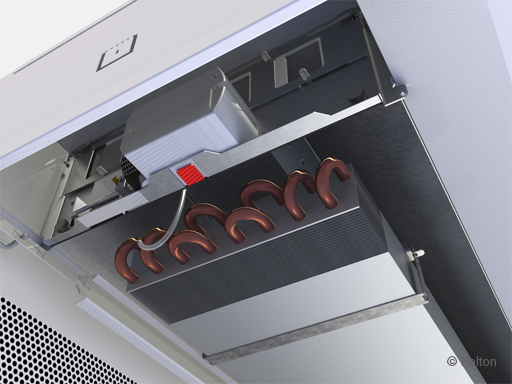
Air quality and temperature controls
The cooling and heating capacities of the chilled beam are controlled by regulating the water flow rate according to the control signal of the room temperature controller.
Air quality control for a room space can be arranged using, e.g., a CO2 sensor when room air temperature is controlled separately by regulating the water flow rate. Alternatively, a temperature sensor can be used for air quality control, with the airflow rate modulated in the first sequence and, if the temperature exceeds the set point, the water valve starting to open in the second sequence.
In heating mode, it is recommended that the temperature difference between the jet outlet and room air would not be greater than 3 °C. The inlet water temperature of the heat exchanger should not be higher than 35 °C. Optimal heating performance requires an appropriate primary air flow rate. Thus, the air handling unit shall operate during heating periods to ensure proper heating performance.
System package
Halton Workplace WRA room automation system package for Halton Rex 600 (RE6) chilled beam
Halton Workplace WRA is part of the Halton Workplace solution offering.
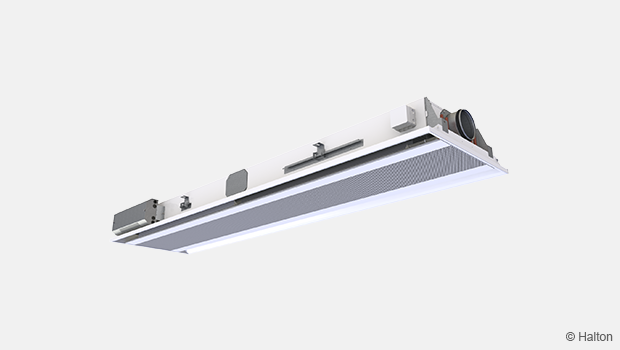
Fig. 1: Halton Workplace WRA room automation controller integrated to Halton Rex 600 (RE6) chilled beam
Halton Workplace WRA is a controller especially designed for controlling the automation system of office spaces and meeting rooms. It is used for controlling the ventilation airflow, room temperature, and indoor air quality.
The Halton Workplace WRA room automation package consists of a controller unit and optional components depending on customer needs: a wall panel and sensors for temperature, CO2, occupancy, pressure, and condensation.
There are options available for the controller unit and wall panel, depending on the number of controls and sensors required. The Halton Workplace WRA room automation controller is always combined with other Halton products for adaptable and high-level indoor climate.
Application area
- Controlling the ventilation airflow, room temperature, and indoor air quality in office spaces and meeting rooms
- The Halton Workplace WRA room automation controller is an important part of the Halton Workplace system, controlling room units and airflow control dampers
- Overall Halton Workplace System includes:
- Room air conditioning applications with Halton Workplace WRA room automation controller:
- Active chilled beams
- Exhaust units
- VAV dampers
- Active VAV diffusers
- Room air conditioning applications with Halton Workplace WRA room automation controller:
- Halton Max MDC zone control dampers
- Halton Workplace WSO system optimiser
Key features
- Factory-tested controller and wiring, easy to install
- Pre-installed project-specific parameters, quick to commission
- Several operating modes based on occupancy, thermal comfort, and indoor air quality
- Enables fully flexible layout solutions for changing needs in office environments
- Highly energy-efficient and reliable system operation
Operating principle
The Halton Workplace WRA room automation controller operates with Variable Air Volume (VAV) dampers and active chilled beams of the Halton Workplace system. These are used for adjusting the ventilation airflow, room temperature, and indoor air quality in office spaces.
Each room unit in an office space can have its own dedicated Halton Workplace WRA room automation controller, or a single controller can control multiple room units. The Halton Workplace WRA room automation controller can automatically adjust the system according to the indoor environment level preferred by users. Each room unit having its own dedicated controller brings maximum flexibility.
Room automation: Halton Rex 600 (RE6) active chilled beams with HAQ control and PTS damper, controlled with Halton Workplace WRA room automation controllers
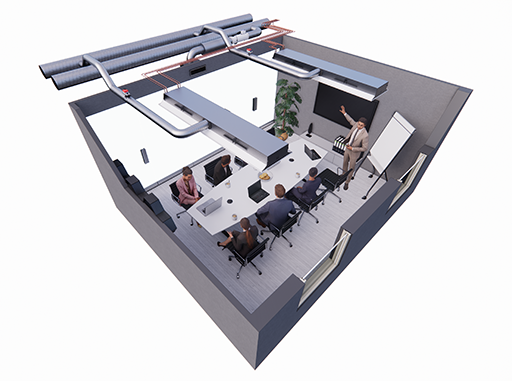
Fig. 2: Halton Rex 600 (RE6) active chilled beams with HAQ control and PTS damper, controlled with Halton Workplace WRA room automation controllers in a meeting room
Room automation description
In this configuration, two Halton Workplace WRA room automation controllers (type DXR2.E18-102A) control two Halton Rex 600 (RE6) active chilled beams. Each chilled beam has heating and cooling valves, motorised Halton Air Quality (HAQ) control, as well as integrated CO2, pressure, and condensation sensors. A Halton PTS single-blade damper is used for controlling the minimum operating mode. The system also includes an exhaust VAV damper, window switch control, external occupancy sensor and a wall panel (type QMX3.P37) with a temperature sensor and display. One Halton Workplace WRA room automation controller can individually control up to four terminal units, and there can be several Halton Workplace WRA room automation controllers in the room.
Design criteria for room automation
- Chilled beam has heating and cooling valves
- Chilled beam has motorised HAQ control
- Chilled beam has integrated CO2, pressure, and condensation sensors
- External occupancy sensor
- Wall panel with temperature sensor and display
- Window switch control
- Optional PTS damper for controlling minimum airflow
- Exhaust airflow control
Schematic drawing

Fig. 3: Schematic drawing: Halton Rex 600 (RE6) chilled beam (4-pipe) controlled with Halton Workplace WRA room automation controller
Equipment list
| Code | Equipment |
| RC | Controller unit |
| FG | Airflow damper actuator |
| FC | Airflow measurement |
| H | Water valve actuator |
| CS | Condensation sensor |
| OS | Occupancy sensor |
| PE | Pressure sensor |
| CO2 | CO2 sensor |
| WP | Wall panel |
| TE | Temperature sensor |
| TI | Temperature display |
| WS | Window switch control |
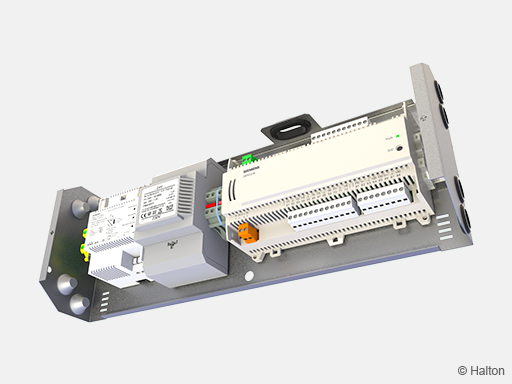
Fig. 4: Factory-installed Halton Workplace WRA room automation controller, type DXR2.E18-102A
Wiring diagram
For the wiring diagram of similar configuration, see Halton Workplace WRA room automation controller product page / section Installation information.
Components and order code examples for the system
- 2 x Active chilled beam: Halton Rex 600 (RE6)
RE6/B-2400-2100-R2N, TC=H, CE=S, CO=SW AQ=B, EX=N, ZT=N - 1 x Exhaust unit: Halton AGC Exhaust grille + Halton PRL Plenum for grilles
AGC/N-400-100 FS=CL, ME=A, FI=PN, CO=W, ZT=N+PRL/F-400-100-160 - 1 x VAV damper: Halton Max Ultra Circular (MUC) or Halton Max One Circular (MOC)
MUC/G-160, MA=CS - 2 x standby, shut-off damper: Halton PTS
PTS/A-125, MA=CS, MO=B4, ZT=N - Automation package: 2 x Halton Workplace WRA room automation controller unit with related components
WRA/RE6-E81-H3-EX4, WP=37, LC=NA, SE=CI, SW=NC, ST=IA, SL=OI, PM=P1, TC=H, CV=SP5, RV=NA, ZT=N
NOTE: Further information can be found on Halton Workplace WRA room automation controller product page
Cooling and heating water valve selection in Halton Workplace WRA room automation system package
Water valve selection is done in Halton Workplace WRA room automation system package. Water valve sizing depends on the number of secondary and primary chilled beam units that are controlled with single controller. One water valve is used to control the whole chilled beam group cooling or heating operated by one room controller. Water valve is sized for whole group when there are multiple chilled beams controlled with single controller unit. There can be one primary chilled beam with room controller and up to three secondary chilled beams. Water valve sizing for 1-4 chilled beams is shown below.
| Number of chilled beams (pcs.) | Water valve type | Size for cooling (DN) | Size for heating (DN) | Installation |
| 1 | ABQM | DN15 | DN15 | Integrated to chilled beam |
| 2 | ABQM | DN20 | DN15 | Loose |
| 3 | ABQM | DN20 | DN15 | Loose |
| 4 | ABQM | DN25 | DN15 | Loose |
| Number of chilled beams (pcs.) | Water valve type | Size for cooling (DN) | Size for heating (DN) | Installation |
| 1 | VPP46.. | DN15 | DN15 | Loose |
| 2 | VPP46.. | DN20 | DN15 | Loose |
| 3 | VPP46.. | DN20 | DN15 | Loose |
| 4 | VPP46.. | DN25 | DN15 | Loose |
Installation
The Halton Rex 600 adabtable chilled beam is especially suitable for ceiling mounting running parallel to exterior wall of the room. When selecting of the chilled beam orientation, the location of the supply air and water circuit connections are taken into account.
The chilled beam can be attached directly to the ceiling surface (H1 = 195 mm) or suspended using threaded drop rods (8 mm). Each beam is equipped with movable brackets fixed to both sides of the beam. It is recommended that the brackets be positioned one quarter of the unit length (L/4) away from the end of the beam.
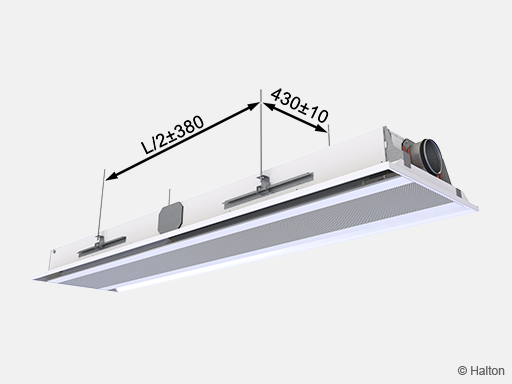
Install the main pipelines of the cooling and heating water circuits above the level of the chilled beam in order to enable venting of the pipework.
The duct connection is at the same end of the chilled beam as the pipe connections. Relocation of the duct connection to either side of the chilled beam can be done easily on-site by using a screw driver.
An optional exhaust valve is installed in the front. Only left and right supply air duct connections are possible. By choosing the exhaust valve option, the active length is total length (L) – 500mm.
Duct installation of the exhaust valve

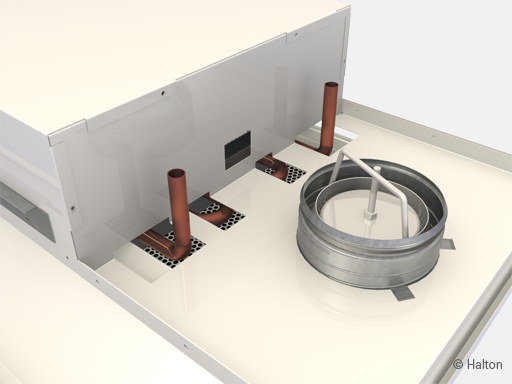
Replacing manual HAQ with motorised HAQ
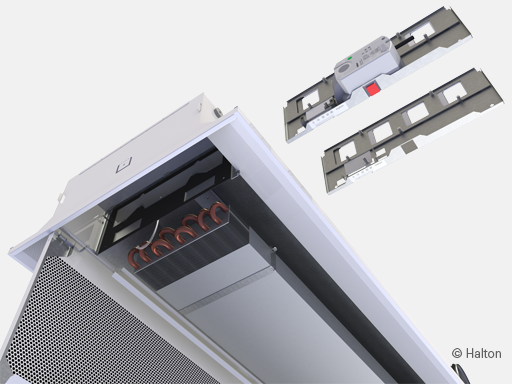
Power supply: 24 VAC.
Control signal: 0 … 10 VDC
Adjustment
Cooling
The recommended cooling water mass flow rate is 0.02 – 0.10 kg/s, resulting in a temperature rise of 1 – 4 °C in the heat exchanger. To avoid condensation, the recommended inlet water temperature of the heat exchanger is 14 – 16 °C.
Heating
The recommended heating water mass flow rate is 0.01 – 0.04 kg/s, resulting in a temperature drop of 5 – 15 °C in the heat exchanger.
The maximum temperature of the inlet water for the heat exchanger is 35 °C.
Balancing and control of water flow rates
Balance the water flow rates of the chilled beam with adjustment valves installed on the outlet side of the cooling and heating water loops. The cooling capacity and heating capacity of the chilled beam are controlled by regulating the water mass flow rate. The water mass flow rate can be controlled by using an ON/OFF valve or a two- or three-way proportional valve.
Adjustment of supply airflow rate
Connect a manometer in the measurement tap and measure the static pressure in the chilled beam. The airflow rate is calculated according to the formula below.
Total airflow rate (qv)

qv Total airflow rate, l/s or m3/h
qv1 Nozzle jet airflow rate, l/s or m3/h
qv2 Air quality control diffuser (HAQ) airflow rate, l/s or m3/h
Nozzle jet airflow rate (qv1)

l eff Length of the coil [m]
Δpm Measured static chamber pressure [Pa]
| Nozzle | k (l/s) | k (m3/h) |
| A | 0.71 | 2.56 |
| B | 0,99 | 3,56 |
| C | 1,36 | 4,90 |
| D | 2.09 | 7,52 |
| E | 3,33 | 11,99 |
Air quality control diffuser airflow rate (qv2)
.png)

a HAQ position
Δpm Measured static chamber pressure [Pa]
| k (l/s) | k (m3/h) |
| 0.17 | 0.61 |
Adjustment of the airflow in constant airflow applications
Define the position of HAQ in millimeters that correspond to airflow rate at the actual chamber pressure level.
Adjustment of HAQ is done manually with the help of position scale by adjusting the opening of the unit. It is possible to verify the opening in millimeters on the position scale.
In order to ensure accurate adjustment it is recommended to adjust HAQ-position and in the same time read the targeted chamber pressure using the manometer.
It is also possible to remove the HAQ-unit from the frame by opening two knurled-head screws (4) for the adjustment.
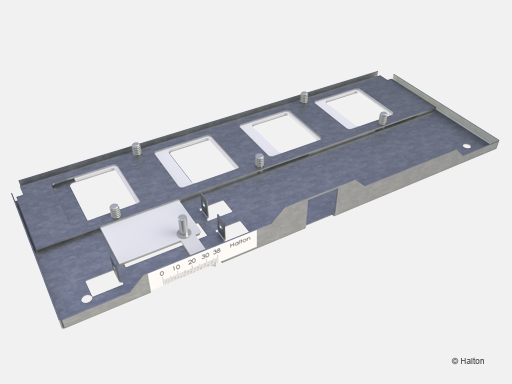
Fig.1. Halton Air Quality control (HAQ), manual
Adjustment of the airflow range in variable airflow applications
Switch-off the power supply of the actuator.
Disengage the actuator gear into manual override position by releasing the knob (1).
Define the maximum and minimum positions, in millimeters that correspond to maximum and minimum airflow rates at the actual chamber pressure level.
The maximum and minimum positions are adjusted with two hexagonal socket set screws (2,3). It is possible to verify the opening in millimeters on the position scale.
Switch on the power supply (24 VAC) of the actuator. The actuator calibrates the min. and max. positions automatically according to the set limits.
The actuator can be controlled from this point on by using a 0…10VDC control signal (0 VDC=min.position, 10 VDC = max. position).
It is also possible to remove the HAQ-unit from the frame by opening two knurled-head screws (4) for the adjustment.
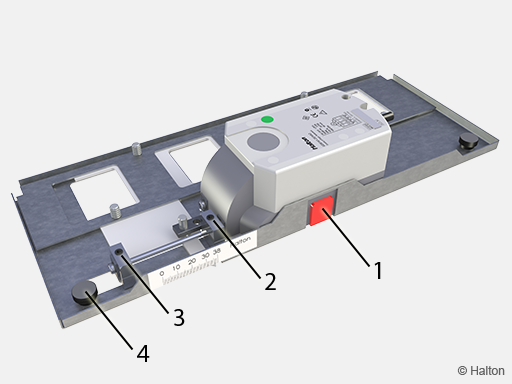
Fig.2. Halton Air Quality control (HAQ), motorised
Key
1. Release of the actuator
2. Restriction of the max. opening
3. Restriction of the min. opening
4. Knurled head screw (2 pcs)
Adjustment of exhaust airflow rate
The valve is adjusted by rotating the central cone. Measure (A) the opening position (in mm) of the central cone. There is a special tool available from Halton for accurate opening position measurement. Set a pressure probe inside the valve, and measure the differential pressure with a manometer. The airflow rate is calculated using the formula below, using k factors presented in the table. After the adjustment, lock the central cone with the locking nut.

| URH 125 | |
| A | k |
| -15 | 0,65 |
| -12 | 0,92 |
| -9 | 1,22 |
| -6 | 1,53 |
| -3 | 1,84 |
| 0 | 2,17 |
| 3 | 2,52 |
| 6 | 2,83 |
| 9 | 3,14 |
| 12 | 3,46 |
| 15 | 3,77 |
Servicing
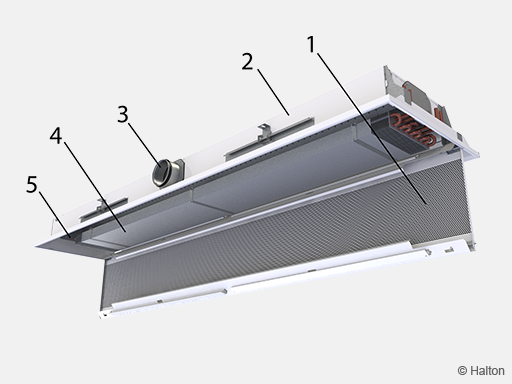
Code description:
1. Front panel
2. Side plate
3. Supply air connection
4. Heat exchanger
5. Halton Air Quality control (HAQ)
Open the front panel of the supply air plenum, the ductwork, and the heat exchanger. In beams longer than 2400 mm, the front panel can be opened in two sections.
Clean the supply air plenum and finned coils of the heat exchanger with a vacuum cleaner, taking care not to damage the finned coils.
Clean the front panel and, if required, the side plates, using a damp cloth.
The Halton Air Quality control unit (HAQ) is removable for chamber cleaning. Unscrew the screws for removing the HAQ.
Specification
The active chilled beam has an integral recirculation air path through the perforated front panel. The induced room air flow rate is manually adjustable via three setting positions without influencing the primary air supply flow rate. The airflow rate of the chilled beam is adjustable without plugging or changing the nozzles.
The primary air flow rate is adjustable over a wide range via a supply air unit integrated into the chilled beam. Adjustment of the air flow rate has not any affect on induced air flow rate through the coil when static chamber pressure is kept constant (optional).
The chilled beam unit equipped with a manually adjustable air flow damper shall be able to be retrofitted with a motorised air flow control damper unit.
Outdoor air flow rate control shall not have any effect on coil cooling and heating capacities.
The beam with adjustable air flow rate shall have only one duct connection.
The appearance of the chilled beams with constant air flow and variable air flow rate shall be the same.
The front panel shall be openable from either side in order to allow general maintenance and cleaning.
The front panel shall be removable without any special tools.
The air supply to the room space shall be either unidirectional or bi-directional.
The active chilled beam shall be 595 mm wide and 195 mm high.
The active chilled beam shall have an inlet duct diameter of 125 mm.
The position of the duct connection shall be changeable without the use of any special tools.
The frame, front, and side panels shall be made of galvanised steel plate.
All visible parts shall be white, painted to RAL 9003 or RAL 9010 (20% gloss).
All pipes shall be manufactured from copper, and connection pipes with a wall thickness of 0.9-1.0 mm.
The fins shall be manufactured from aluminium.
Optionally, heating shall be incorporated within the heat exchanger by means of two 10-mm pipes, connected in series.
All joints shall be soldered and factory pressure-tested.
The pipework s maximum operation pressure is 1.0 MPa.
The active chilled beam shall have an air flow adjustment damper as an option and a measurement tap to allow air flow measurement.
As an option, an exhaust valve shall be integrated into the chilled beam.
Active chilled beams shall be protected by a removable plastic coating and individually wrapped in a plastic.
The duct connection and pipe ends shall remain sealed during transport.
The active chilled beams shall be identified by labels attached to both the active chilled beam and the plastic packaging.
Order code
RE6/S-L-C-E; SP-TC-CE-CO-AQ-EX-ZT
S = Nozzle type
A Extra small
B Small
C Medium
D Large
E Extra large
L = Beam length (mm)
1200,+100,..,3600 (and 1720)
C = Effective/coil length (mm)
900,+100,..,3400
(See in Accessories tab table of effective length of coil
with different accessories and product options)
E = Duct connection (mm)
R2 Right (Ø125)
L2 Left (Ø125)
S2 Straight (Ø125)
Other options and accessories
SP = System package
N No
Y Yes
TC = Cooling /Heating functions (Coil type)
C Cooling
H Cooling and heating
CE = Coil efficiency
N Normal
S Standard, cooling
SL Standard, cooling, low pressure drop
SH Standard, cooling and heating
AQ = Air quality control (HAQ)
MA Manual
MO Motorised
RE Retrofit
NA Not assigned
EX = Exhaust
N No
A URH
CO = Colour
SW Signal white (RAL9003)
W Pure white (RAL 9010)
X Special colour (RALxxxx)
ZT = Tailored product
N No
Y Yes (ETO)
Sub products
System package Halton Workplace WRA
Room exhaust VAV damper Halton Max One Circular (MOC)
Room exhaust VAV damper Halton Max Ultra Circular (MUC)
Code example
RE6-A-3000-2700-R2, SP=N, TC=C, CE=N, CO=SW, AQ=A, EX=N, ZT=N
Downloads
-
Halton Rex RE6 – Chilled beam
Data
en
-
Halton Rex RE6 – Ilmastointipalkki
Data
fi
-
Halton Rex RE6 – Poutre climatique
Data
fr
-
Halton Rex RE6 – Kylbaffel
Data
se
-
Halton Rex RE6 – Fiche technique
Data
fr_FR -
Eurovent Certification for Chilled Beams
Data
English (en) -
Enviromental Product Declaration (EPD) – Halton chilled beams, VAV type
Data
English (en)
